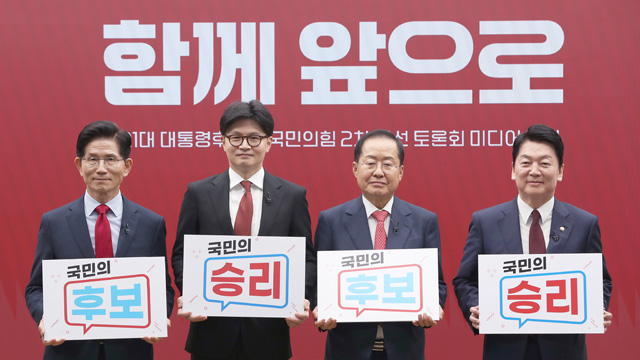S. Korea's forecast for ‘humanoid robots’
입력 2024.10.08 (05:31)
읽어주기 기능은 크롬기반의
브라우저에서만 사용하실 수 있습니다.
[Anchor]
Jensen Huang, the CEO of NVIDIA, a key player in artificial intelligence (AI), said this back in March.
He stated that everything that moves will become a robot, and indeed, with the advancement of AI, robots are becoming increasingly intelligent.
The competition in humanoid robot technology is also intensifying.
There are expectations that robots could become essential electronic devices like smartphones, and companies are rushing to showcase related technologies.
So, how far has our country's robot industry come?
Reporter Hwang Da-ye has looked into it.
[Report]
Moving heavy objects easily and filling empty spaces with cushioning materials is done by robots, not humans.
There are over 120 such robots in this logistics center alone.
As the work speed has increased, the order deadline has been extended by 4 hours, and labor intensity has decreased.
[Kim Hee-tae/CJ Logistics Gunpo Smart Fulfillment Center Director: "Previously, more men were doing the work, but now women can also work at a sufficient level..."]
Existing simple manufacturing robots are becoming smarter by adopting AI brains.
The next step is humanoid robots that resemble humans.
Major tech companies have already begun pilot deployments in their own factories, and the humanoid market size is expected to grow rapidly.
These robots can use both arms freely like a person.
Robots that have gone through such learning processes will apply the same movements in the field.
South Korean companies are also entering the competition in earnest and are heavily engaged in research and development.
[Oh Jae-sung/Senior Researcher at Rainbow Robotics: "It has a wide supporting polygon and support points, so it can maintain balance safely without falling over while performing various movements."]
However, the government analyzes that our robot industry technology is lagging behind not only the United States and Japan but also China.
[Oh Jun-ho/KAIST Mechanical Engineering Chair Professor: "(In terms of) the environment to produce robots, we need to objectively look at whether we are really falling behind China."]
In particular, the low domestic production rate of key components and AI software technology is a challenge for our robot industry ecosystem.
This is KBS News, Hwang Da-ye.
Jensen Huang, the CEO of NVIDIA, a key player in artificial intelligence (AI), said this back in March.
He stated that everything that moves will become a robot, and indeed, with the advancement of AI, robots are becoming increasingly intelligent.
The competition in humanoid robot technology is also intensifying.
There are expectations that robots could become essential electronic devices like smartphones, and companies are rushing to showcase related technologies.
So, how far has our country's robot industry come?
Reporter Hwang Da-ye has looked into it.
[Report]
Moving heavy objects easily and filling empty spaces with cushioning materials is done by robots, not humans.
There are over 120 such robots in this logistics center alone.
As the work speed has increased, the order deadline has been extended by 4 hours, and labor intensity has decreased.
[Kim Hee-tae/CJ Logistics Gunpo Smart Fulfillment Center Director: "Previously, more men were doing the work, but now women can also work at a sufficient level..."]
Existing simple manufacturing robots are becoming smarter by adopting AI brains.
The next step is humanoid robots that resemble humans.
Major tech companies have already begun pilot deployments in their own factories, and the humanoid market size is expected to grow rapidly.
These robots can use both arms freely like a person.
Robots that have gone through such learning processes will apply the same movements in the field.
South Korean companies are also entering the competition in earnest and are heavily engaged in research and development.
[Oh Jae-sung/Senior Researcher at Rainbow Robotics: "It has a wide supporting polygon and support points, so it can maintain balance safely without falling over while performing various movements."]
However, the government analyzes that our robot industry technology is lagging behind not only the United States and Japan but also China.
[Oh Jun-ho/KAIST Mechanical Engineering Chair Professor: "(In terms of) the environment to produce robots, we need to objectively look at whether we are really falling behind China."]
In particular, the low domestic production rate of key components and AI software technology is a challenge for our robot industry ecosystem.
This is KBS News, Hwang Da-ye.
■ 제보하기
▷ 카카오톡 : 'KBS제보' 검색, 채널 추가
▷ 전화 : 02-781-1234, 4444
▷ 이메일 : kbs1234@kbs.co.kr
▷ 유튜브, 네이버, 카카오에서도 KBS뉴스를 구독해주세요!
- S. Korea's forecast for ‘humanoid robots’
-
- 입력 2024-10-08 05:31:04

[Anchor]
Jensen Huang, the CEO of NVIDIA, a key player in artificial intelligence (AI), said this back in March.
He stated that everything that moves will become a robot, and indeed, with the advancement of AI, robots are becoming increasingly intelligent.
The competition in humanoid robot technology is also intensifying.
There are expectations that robots could become essential electronic devices like smartphones, and companies are rushing to showcase related technologies.
So, how far has our country's robot industry come?
Reporter Hwang Da-ye has looked into it.
[Report]
Moving heavy objects easily and filling empty spaces with cushioning materials is done by robots, not humans.
There are over 120 such robots in this logistics center alone.
As the work speed has increased, the order deadline has been extended by 4 hours, and labor intensity has decreased.
[Kim Hee-tae/CJ Logistics Gunpo Smart Fulfillment Center Director: "Previously, more men were doing the work, but now women can also work at a sufficient level..."]
Existing simple manufacturing robots are becoming smarter by adopting AI brains.
The next step is humanoid robots that resemble humans.
Major tech companies have already begun pilot deployments in their own factories, and the humanoid market size is expected to grow rapidly.
These robots can use both arms freely like a person.
Robots that have gone through such learning processes will apply the same movements in the field.
South Korean companies are also entering the competition in earnest and are heavily engaged in research and development.
[Oh Jae-sung/Senior Researcher at Rainbow Robotics: "It has a wide supporting polygon and support points, so it can maintain balance safely without falling over while performing various movements."]
However, the government analyzes that our robot industry technology is lagging behind not only the United States and Japan but also China.
[Oh Jun-ho/KAIST Mechanical Engineering Chair Professor: "(In terms of) the environment to produce robots, we need to objectively look at whether we are really falling behind China."]
In particular, the low domestic production rate of key components and AI software technology is a challenge for our robot industry ecosystem.
This is KBS News, Hwang Da-ye.
Jensen Huang, the CEO of NVIDIA, a key player in artificial intelligence (AI), said this back in March.
He stated that everything that moves will become a robot, and indeed, with the advancement of AI, robots are becoming increasingly intelligent.
The competition in humanoid robot technology is also intensifying.
There are expectations that robots could become essential electronic devices like smartphones, and companies are rushing to showcase related technologies.
So, how far has our country's robot industry come?
Reporter Hwang Da-ye has looked into it.
[Report]
Moving heavy objects easily and filling empty spaces with cushioning materials is done by robots, not humans.
There are over 120 such robots in this logistics center alone.
As the work speed has increased, the order deadline has been extended by 4 hours, and labor intensity has decreased.
[Kim Hee-tae/CJ Logistics Gunpo Smart Fulfillment Center Director: "Previously, more men were doing the work, but now women can also work at a sufficient level..."]
Existing simple manufacturing robots are becoming smarter by adopting AI brains.
The next step is humanoid robots that resemble humans.
Major tech companies have already begun pilot deployments in their own factories, and the humanoid market size is expected to grow rapidly.
These robots can use both arms freely like a person.
Robots that have gone through such learning processes will apply the same movements in the field.
South Korean companies are also entering the competition in earnest and are heavily engaged in research and development.
[Oh Jae-sung/Senior Researcher at Rainbow Robotics: "It has a wide supporting polygon and support points, so it can maintain balance safely without falling over while performing various movements."]
However, the government analyzes that our robot industry technology is lagging behind not only the United States and Japan but also China.
[Oh Jun-ho/KAIST Mechanical Engineering Chair Professor: "(In terms of) the environment to produce robots, we need to objectively look at whether we are really falling behind China."]
In particular, the low domestic production rate of key components and AI software technology is a challenge for our robot industry ecosystem.
This is KBS News, Hwang Da-ye.
-
-

황다예 기자 allyes@kbs.co.kr
황다예 기자의 기사 모음
-
이 기사가 좋으셨다면
-
좋아요
0
-
응원해요
0
-
후속 원해요
0










![[속보] 이재명, 민주당 호남 경선서 88.69%로 1위…충청보다 득표율 높아](/data/layer/904/2025/04/20250426_yKnEKN.jpg)




이 기사에 대한 의견을 남겨주세요.